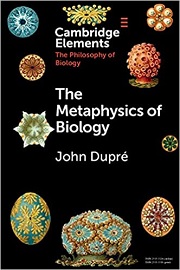The Metaphysics Of Biology

John Dupre
Cambridge University Press, £15.00
What are we talking about when we talk about things in biology? This isn't a trick question, and it gets to the essence of philosopher of biology John Dupre's The Metaphysics Of Biology. This brief introduction in the Cambridge Elements series considers what biological entities are, and how our talk about such things fits into theoretical frameworks.
The book is divided into two separate but related sections. The first concerns metaphysical questions concerning reductionism, emergence, causation, and ontological issues of whether biological entities such as cells, organisms or species are best considered as 'things' or as 'processes'. Dupre is open about taking a 'process-ontological' view. He considers biological structures to be 'slow processes' and functions to be 'fast processes'. This is grounded in the observations that living things are constantly metabolically active, have life cycles and are in constant flux, while also often being obligately symbiotic (for example, our dependence on populations of gut bacteria).
Dupre rejects theoretical reductionism in biology; namely that phenomena at higher levels of organisation in biology can be explained by events and processes at more fundamental levels, and tends toward 'emergence' as a framework for accounting for the explanatory structure at higher levels of organisation. For Dupre, reductionist thinkers mistake claims about the world with claims about our representation of the world. He is a materialist, but not a theoretical reductionist – because our theories are often built on models, which are necessarily abstractions which may not obtain total correspondence with the world.
The second half of the book deals with biological concepts themselves; cells, species, populations and more. Essentially, for Dupre, life is a hierarchy of processes, stabilised by other processes at lower levels, and embedded in higher level processes. Interestingly, in the context of the Covid-19 pandemic, he considers where viruses fit into such a conception of life. While it's easy to dismiss the idea of a virion particle as alive, is it as easy to dismiss the entire viral life cycle in the same manner? Is the boundary between life and non-life sharply defined?
Overall, Dupre is aware that his take is somewhat contested, and this humility is refreshing. His arguments are compelling, and the book would usefully be read in contrast to Alex Rosenberg's Reduction and Mechanism, which takes an opposing view in terms of reductionism, but is not easily dismissed. Together, the different perspectives are thought-provoking in terms of considering what we mean when we talk about things in biology.
Conor McCrory MRSB


